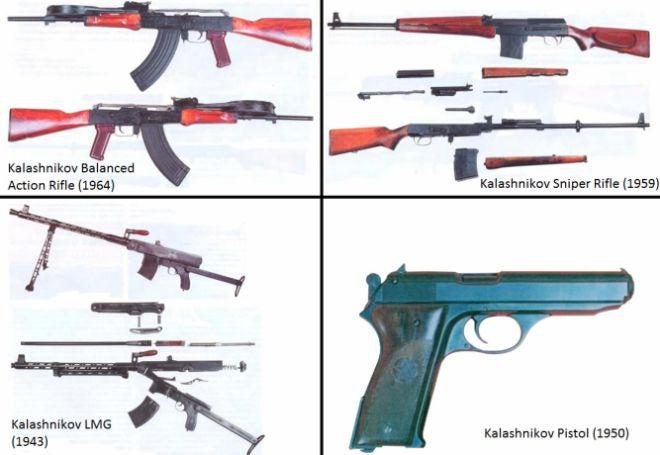Mikhail Kalashnikov has designed a number of firearms other than AK family of rifles he is famous for. Some of them were experimental, others took part in various trials, but because they lost and were never adopted, they’ve become forgotten.
A couple of weeks ago TFB writer Nathaniel F wrote an article, where he discussed several less known Kalashnikov designs. His article was written in defense of Mikhail Kalashnikov against the conspiracy theorists, who insist that Kalashnikov was not the real designer of AK-47. One of their arguments is that if he was, he would have designed other guns too. So this article is sort of a follow-up to Nathaniel’s one, and its purpose is to show you four more guns by Mikhail Kalashnikov.
So, without further ado, let’s take a look at these guns in chronological order starting from the earliest:
1) Kalashnikov Light Machine Gun (1943)
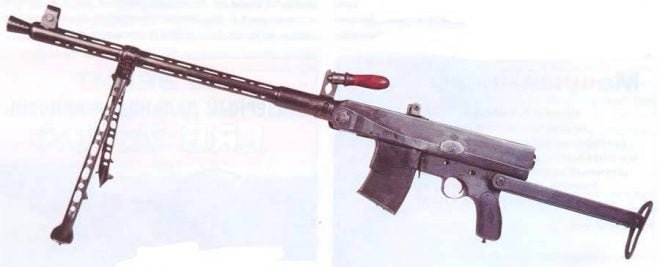
The experience of early years of WW2 showed that although the Soviets had good tactics of LMG deployment, the guns themselves (namely DP LMG) needed some improvements. They needed a new gun, which would be lightweight enough to be carried (along with ammunition) by a single soldier, without a need for an assistant gunner.
So in 1942 Soviets formed the specifications for a new LMG. It had to be chambered in 7.62x54R and weigh no more than 7.5kg (16.5 lbs). The effective rate of fire (not to be confused with cyclic rate) was to be 100 rpm and the barrel had to be able to withstand 500 rounds of continuous fire at such effective rate without a need to be cooled.
In June of 1942, Degtyaryov, Vladimirov, Simonov, Goryunov and then starting arms designer Mikhail Kalashnikov submitted their versions of the new LMG. Mikhail designed the gun within 2.5 months and about five samples were submitted to the trials committee.

Kalashnikov’s LMG had a short barrel recoil action and was the only one to use that system. All other competitor guns were gas operated. It was fed from a 15 round detachable box magazine. Locking of the action was accomplished by a receiver mounted tilting lever, which blocked the bolt by sneaking behind it.
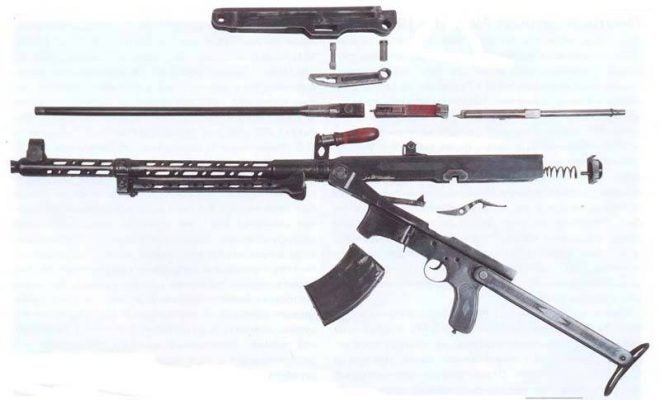
The gun was full auto only and the perforated barrel shroud was supposed to aid the cooling of barrel. It had a carry handle and a folding (“underfolder”) stock. So overall it had several unique solutions setting it apart from the competition.
As a result of these trials Degtyaryov’s design, which was basically an upgraded DP LMG, was recognized as the most successful and eventually adopted as the DPM LMG.
2) Kalashnikov Automatic Pistol (1950)
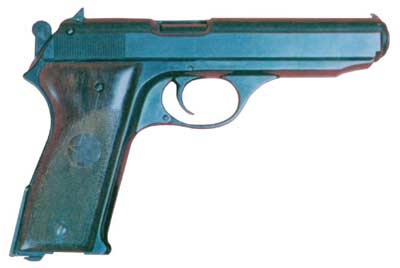
In the early 1950s, the Soviet Union military officials realized that they need a special gun to arm armored vehicle and artillery crews. These units didn’t need a full-size AK-47 rifle, but also wanted something more capable than the Makarov pistol. In other words, they needed what we call today PDW. The requirements were much like ones that launched M1 Carbine trials earlier in the USA. However, Soviets decided not to go with a new cartridge development, but to develop a select fire large pistol chambered in 9x18mm. With a shoulder stock attachment and high capacity, it was considered capable of fulfilling the role.
The result of these trials was the adoption of Stechkin Automatic Pistol (APS). As you might have guessed, Mikhail Kalashnikov has submitted his own version of the pistol – Kalashnikov Automatic Pistol.
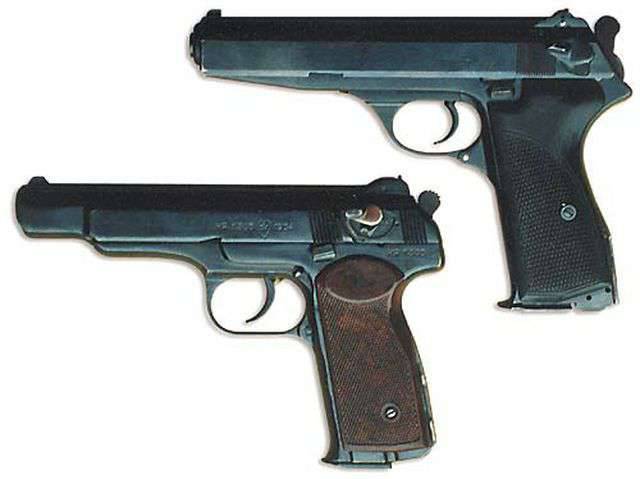
Top – Kalashnikov Automatic Pistol Bottom – Stechkin Automatic Pistol (APS)
Although Kalashnikov’s pistol was denied at early stages of the trials, it had some unique features. Particularly, it had very simple design solutions. By that time, the AK-47 has already been adopted and apparently Kalashnikov has developed his famous approach of designing simple and reliable guns.
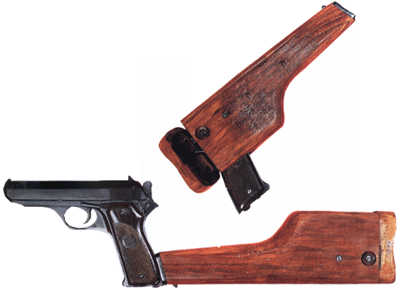
The safety selector lever of the pistol had three positions: safe/decocker, single shot and full auto. It was fed from an 18 round magazine and for sake of simplicity, it was a single action only gun. The pistol also lacked any measure of cyclic rate reduction, so it had an extremely high rate of fire.
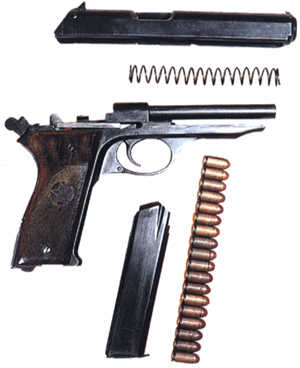
This pistol was sort of a side project for Mikhail Kalashnikov. By that time he was already busy with the assault rifle and LMG developments. Many experts state, that if he had more time to devote to this pistol design, he could have good chances to win the trials.
3) Kalashnikov Sniper Rifle (1959)


In 1958 the Soviet Union started a project of development of a sniper rifle chambered in 7.62x54R. The new rifle was supposed to replace Mosin-Nagant and SVT rifles in sniper and DMR roles. Trials begun in 1959 and four rifles were submitted. These guns were designs of Dragunov, Konstantinov, Simonov and Kalashnikov.
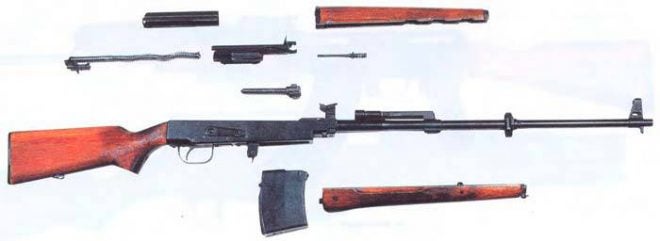
Kalashnikov’s rifle was gas operated with a short stroke piston. Many design features he transferred from the AK-47. The gun was fed from a 10 round detachable box magazine, but it also had a possibility to load the magazine by stripper clips from atop of the receiver, using a cutout in bolt carrier as a stripper clip guide. The rifle also had an optics mounting rail on the left side of the receiver.
Kalashnikov’s sniper rifle was also very reliable, but it failed to meet the precision and accuracy requirements of the trials. Because of that, it was removed from the project. The trials lasted four years. Eventually, Yevgeny Dragunov’s design won and was adopted in 1963 as the Dragunov Sniper Rifle – SVD.
4) Kalashnikov Experimental Rifle (1964)


This gun was Mikhail Kalashnikov’s version of balanced action system. Right above the barrel it had two rotating parts connected to the bolt carrier. During the firing cycle, gasses forced that parts to rotate in opposite directions and hit each other. That way they canceled the recoil impulse of moving parts and prevented bolt carrier from hitting the rear trunnion.
The rifle remained an experimental one and wasn’t further developed. It was rather a proof of concept, than a practical design meant to be adopted.
Conclusion
I think presented four guns along with ones from Nathaniel’s article are more than enough to proof, that Kalashnikov was an ingenious firearms designer. It is clear, that before and after AK-47 he had several different small arms design projects accomplished.
Sources:
www.topwar.ru
www.megasword.ru
 Your Privacy Choices
Your Privacy Choices
